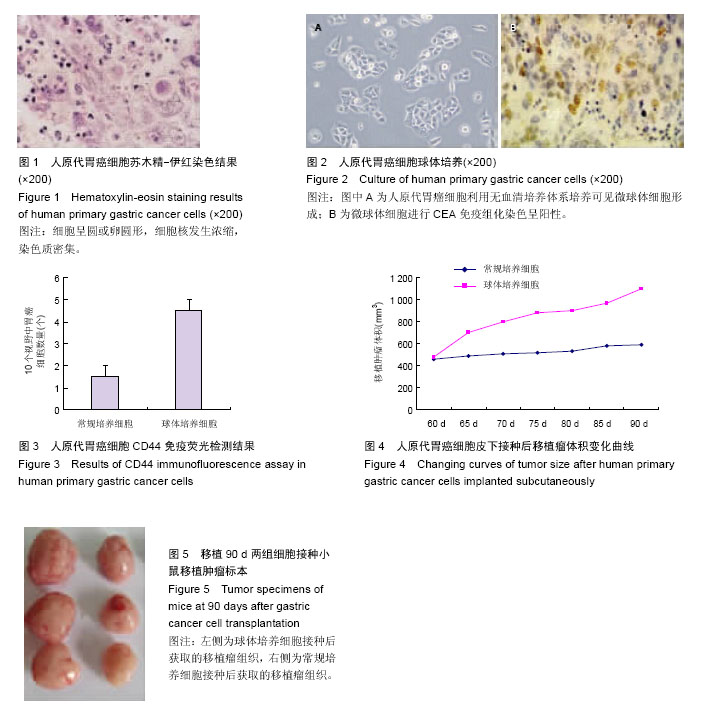| [1] 孙卯.CD44+胃癌细胞的肿瘤干细胞特性鉴定及其与癌侵袭相关性研究[D]. 重庆:重庆医科大学,2013.
[2] 杨宏琼,陆亚华,周志华,等.人胃癌细胞株BGC-823克隆形态观察及其CD44表达变化[J].山东医药,2015, 55(34): 24-25
[3] 刘建明,马利林,周友浪,等.CD44在胃癌细胞株MKN45悬浮球体细胞中的表达及意义[J].交通医学,2013,27(6): 601-603,606.
[4] Kanzawa M, Semba S, Hara S, et al. WNT5A is a key regulator of the epithelial-mesenchymal transition and cancer stem cell properties in human gastric carcinoma cells. Pathobiology. 2013;80(5):235-244.
[5] Yu L, Yang L, An W, et al. Anticancer bioactive peptide-3 inhibits human gastric cancer growth by suppressing gastric cancer stem cells. J Cell Biochem. 2014;115(4):697-711.
[6] Wang YY, Liu J, Zheng Q, et al. Effect of the parvovirus H-1 non-structural protein NS1 on the tumorigenicity of human gastric cancer cells. J Dig Dis. 2012;13(7): 366-373.
[7] Kim KY, Yi BR, Lee HR, et al. Stem cells with fused gene expression of cytosine deaminase and interferon-β migrate to human gastric cancer cells and result in synergistic growth inhibition for potential therapeutic use. Int J Oncol. 2012;40(4):1097-1104.
[8] 吴松洁,贾晓渊,钱其军,等.人胃癌细胞系BGC-823中SP细胞的耐药性研究[J].浙江理工大学学报,2008,25(5): 573-577.
[9] 王宁,陈凛,卫勃,等.胃癌MKN-28肿瘤细胞系SP细胞亚群初步分析[C].2008胃肠肿瘤外科综合诊治高峰论坛论文集,2008:324-328.
[10] Zhu X, Su D, Xuan S, et al. Gene therapy of gastric cancer using LIGHT-secreting human umbilical cord blood-derived mesenchymal stem cells. Gastric Cancer. 2013;16(2):155-166.
[11] Li Y, Zhao Y, Cheng Z, et al. Mesenchymal stem cell-like cells from children foreskin inhibit the growth of SGC-7901 gastric cancer cells. Exp Mol Pathol. 2013; 94(3):430-437.
[12] Hasegawa T, Yashiro M, Nishii T, et al. Cancer-associated fibroblasts might sustain the stemness of scirrhous gastric cancer cells via transforming growth factor-β signaling. Int J Cancer. 2014;134(8):1785-1795.
[13] Voon DC, Wang H, Koo JK, et al. Runx3 protects gastric epithelial cells against epithelial-mesenchymal transition-induced cellular plasticity and tumorigenicity. Stem Cells. 2012;30(10):2088-2099.
[14] 王佳佳,孙立新,孙力超,等.人胃癌CD90+干细胞可能影响胃癌的转移和患者的预后[J].中国肿瘤生物治疗杂志, 2013,20(2):230-236.
[15] Hong KJ, Wu DC, Cheng KH, et al. RECK inhibits stemness gene expression and tumorigenicity of gastric cancer cells by suppressing ADAM-mediated Notch1 activation. J Cell Physiol. 2014;229(2):191-201.
[16] Yano S, Tazawa H, Hashimoto Y, et al. A genetically engineered oncolytic adenovirus decoys and lethally traps quiescent cancer stem-like cells in S/G2/M phases. Clin Cancer Res. 2013;19(23):6495-6505.
[17] Shan YS, Fang JH, Lai MD, et al. Establishment of an orthotopic transplantable gastric cancer animal model for studying the immunological effects of new cancer therapeutic modules. Mol Carcinog. 2011;50(10): 739-750.
[18] 刘建明,周友浪,马利林,等.Nanog与CD44在胃癌细胞株MKN45球体细胞中的表达及其意义[J].天津医药,2015, 43(1):30-33.
[19] 徐志远,程向东,杜义安,等.化疗后残余胃癌细胞发生上皮间质转化的体外研究[J].中国肿瘤临床,2013,40(18): 1085-1088.
[20] Dardaei L, Shahsavani R, Ghavamzadeh A, et al. The detection of disseminated tumor cells in bone marrow and peripheral blood of gastric cancer patients by multimarker (CEA, CK20, TFF1 and MUC2) quantitative real-time PCR. Clin Biochem. 2011;44(4): 325-330.
[21] 许扬梅.胃癌细胞系SGC-7901肿瘤干细胞的初步研究[D].福州:福建医科大学,2008.
[22] Liu G, Neumeister M, Reichensperger J, et al. Therapeutic potential of human adipose stem cells in a cancer stem cell-like gastric cancer cell model. Int J Oncol. 2013;43(4):1301-1309.
[23] She JJ, Zhang PG, Wang X, et al. Side population cells isolated from KATO III human gastric cancer cell line have cancer stem cell-like characteristics. World J Gastroenterol. 2012;18(33):4610-4617.
[24] Liu J, Ma L, Xu J, et al. Spheroid body-forming cells in the human gastric cancer cell line MKN-45 possess cancer stem cell properties. Int J Oncol. 2013;42(2): 453-459.
[25] Chen T, Yang K, Yu J, et al. Identification and expansion of cancer stem cells in tumor tissues and peripheral blood derived from gastric adenocarcinoma patients. Cell Res. 2012;22(1):248-258.
[26] Li R, Wu X, Wei H, et al. Characterization of side population cells isolated from the gastric cancer cell line SGC-7901. Oncol Lett. 2013;5(3):877-883.
[27] Jiang J, Zhang Y, Chuai S, et al. Trastuzumab (herceptin) targets gastric cancer stem cells characterized by CD90 phenotype. Oncogene. 2012;31(6):671-682.
[28] 匡弢,王雷,宋文,等.胃癌肿瘤干细胞的分离与成脂分化[J].中国组织工程研究与临床康复,2011,15(36):6718-6721.
[29] 刘建明.microRNA在胃癌细胞株MKN-45肿瘤干细胞中的表达谱研究[D]. 苏州:苏州大学,2014.
[30] 蔡建英,杨效东,周明川,等.上调miR-21表达水平对胃癌KatoⅢ细胞中CD44mRNA及蛋白表达的影响[J].吉林大学学报:医学版,2013,39(4):751-754.
[31] Zhao BC, Zhao B, Han JG, et al. Adipose-derived stem cells promote gastric cancer cell growth, migration and invasion through SDF-1/CXCR4 axis. Hepatogastroenterology. 2010;57(104):1382-1389.
[32] Takaishi S, Okumura T, Tu S,et al. Identification of gastric cancer stem cells using the cell surface marker CD44. Stem Cells. 2009;27(5):1006-1020.
[33] 周雨,胡程,段海瑞,等.CD44+胃癌细胞的获取及其干细胞特性的初步鉴定[J].大家健康:下旬版,2014,8(1):4-5,6.
[34] Giannakis M, Chen SL, Karam SM, et al. Helicobacter pylori evolution during progression from chronic atrophic gastritis to gastric cancer and its impact on gastric stem cells. Proc Natl Acad Sci U S A. 2008; 105(11):4358-4363.
[35] 张海宏,魏学明,范勤,等.MKN-45侧群细胞的肿瘤干细胞干性特征分析[J].空军医学杂志,2013,29(1):36-40.
[36] 李振丰.人胃癌细胞SGC7901中CSCs样细胞筛选及DADS诱导的生长抑制作用[D]. 衡阳:南华大学,2011.
[37] 王宁,陈凛,卫勃,等.胃癌MKN-28肿瘤细胞系SP细胞亚群初步分析[J].世界华人消化杂志,2007,15(9):1000-1003.
[38] 许扬梅,龚福生,陈雪芳,等.胃癌细胞系SGC-7901肿瘤干细胞样细胞的分离和鉴定[J].福建医科大学学报,2013, (4):223-227.
[39] 杨宏琼,周志华,张尤历,等.人胃癌细胞株SGC-7901的克隆形态观察及含肿瘤干细胞克隆的鉴定[J].中华肿瘤杂志,2013,35(3):164-169.
[40] 王守练,俞继卫,蔡成,等.RNA干扰抑制KATO-Ⅲ CD133阳性胃癌细胞CD133基因表达及对其生物学特性的影响[J].中华胃肠外科杂志,2013,16(9):889-894. |
.jpg)

.jpg)
.jpg)